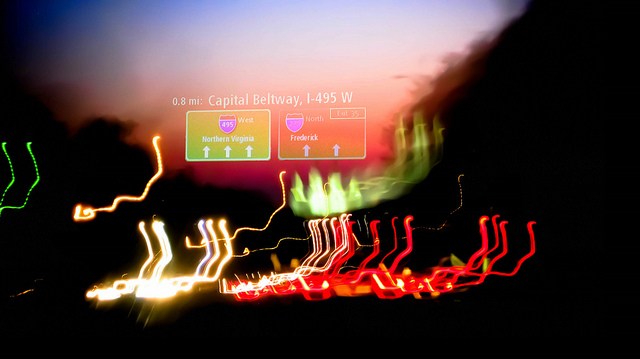Podcast: Play in new window | Download
Subscribe: RSS

On a normal night, the Capital Beltway around Washington DC looks like this; it’s going to get worse. (Photo by trekkyandy/Flickr)
Its merits as a highway aside, the Capital Beltway (the 64-mile-long ring road around Washington, DC) has served this nation well, for more than half a century, as a metaphor. There simply is no better, quicker or less obscene way to describe a political hack than to invoke “inside-the-beltway thinking.” Or to plead for common sense than to suggest someone take a look at things “outside the Beltway.” Now the Beltway is dying, and in doing so is providing an even better metaphor, for the entire crash of the industrial age. It’s almost as good as the Titanic.
The interstate highway system of which the Capital Beltway is a part was begun in the 1950s and substantially finished in the 1980s. Nearly 50,000 miles in length, it cost the country $425 billion and is referred to by admirers as the largest public works project since the pyramids. (Really? Building tombs for emperors was a public works program?) The Beltway, completed in 1964, shared with its fellow highways a life expectancy of 50 years. Do the math.
Last weekend the Washington Post wrote the Beltway’s obituary. Like a very elderly person, the Beltway’s ills have proceeded from the superficial (potholes, easily fixed with a dab of cosmetic) to failure of the vital organs (the base that supports the asphalt is turning, in the apt phrasing of the Post article, “to mush”). This is because the potholes don’t get fixed in a timely manner, they admit water to the roadbed below, in winter it freezes and widens the cracks, and pretty soon the potholes become craters and the roadbed becomes, well, mush.
Actually, the 50-year actuarial lifespan is best-case, because designers never foresaw the beating these roads are taking. One intersection on the Beltway (with Interstate 270 in Maryland) sees a quarter of a million cars per day. Since 1990, car traffic on the Interstate system has jumped more than a third, and 18-wheeler truck traffic by more than half. People who drive the Beltway say the good news is that there’s no more rush hour; the bad news is that it’s because the road is at or near gridlock 24/7.
How much would it cost to fix? Call it a gazillion dollars, a number so far in the stratosphere of this no-new-taxes country that there is no point in affixing a real number. The American Society of Civil Engineers says that to avoid catastrophe, the country as whole needs to spend $79 billion on its highways. A year. For the foreseeable future.
If you had the money, you would have to close big chunks of the Beltway for months at a time to get the work done. Even if you did it one lane at a time, an approach that would more than double the cost, traffic engineers say the result would be, well, carmageddon — area wide, intractable gridlock.
This, of course, may not be true. Carmageddon is a word coined to describe something predicted, twice, in California when major Interstates were shut down for repairs. Both times, nothing happened. Turns out people have choices, and when the highway is closed they take the train. Who would have thought?
Still, the prospect of gridlock prevents action that might be proposed if there were any prospect of money. The Post article makes much of a few incremental increases in the transportation budgets of Virginia and Maryland.
The reality, though, is that officials responsible for the public welfare continue to work furiously to stay in office, to placate their wealthy donors, to get face time on TV, and to hope they will get their pension before the Interstates die, the bridges fall, the climate changes, the oil peaks, the wells go dry, the food runs out and the lights go out.
If there ever was a time for Beltway tightening — it was about ten years ago.
Well said. Those of us who have spent the majority of our lives inside the beltway(or very close to it) can certainly appreciate that it is a path that not only closes off our national politicians from average citizens, but it is a trail that takes those on it in circles. No real destination, you just end up back where you started. Sort of like an asphalt version of the movie Groundhog Day with Bill Murry…